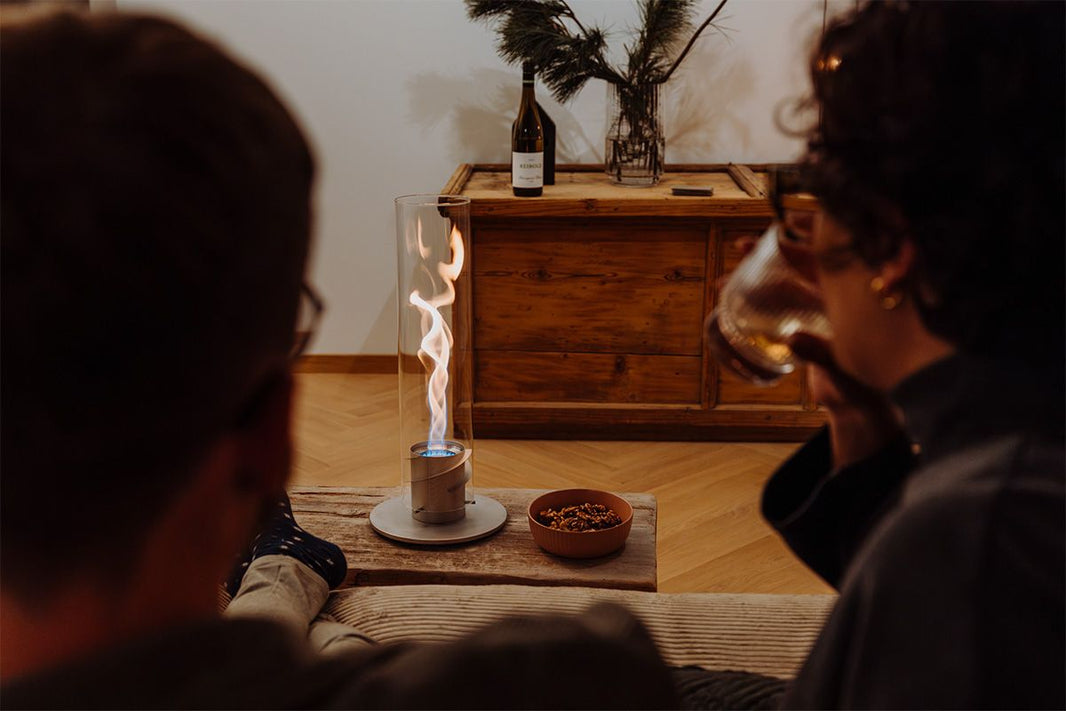The history of artificial lighting is interwoven with discoveries that have brightened our nights for centuries. Two of the pioneers of this luminous heritage, the oil lamp and the kerosene lamp, still have a bright future ahead of them. Let's discover the differences between oil and kerosene lamps.
Discover Peri Design oil lamps.
Which oils are recommended for traditional lamps?
Traditional oil lamps use oil produced from vegetable sources. These are liquid fuels specially designed for these lamps, or more or less dedicated to this use (you'll see!).
Here are some of the oils commonly recommended for traditional lamps:
- Kerosene oil: This is the oil most commonly used for this type of lamp. It undergoes a thorough refining process and has a pleasant, subtle fragrance (source: science-labs).
- Lemongrass oil: Sometimes used for its insect-repellent properties, lemongrass oil can be used in certain outdoor oil lamps (you've got to love the smell!).
- Olive oil: Yes, it's possible! In certain situations, olive oil can be used as an alternative. In fact, our ancestors used vegetable oils of this type to fuel their lamps. It is not strongly recommended, however, as it can give off more smoke and produce a distinct odor during combustion.
Above all, it's important to always check the instruction manual for your lighting device for the manufacturer's specific recommendations on the type of oil to use. Some lamp types may be designed to operate with specific oils, and using the wrong oil could damage the lamp or compromise safety.

What are the different fuels for kerosene lamps?
Kerosene lamps generally use specific, more flammable and volatile liquid fuels in their tanks. Their distillation is more complex to implement.
Here are some of the fuels commonly used in kerosene lamps (non-exhaustive list):
- Kerosene: This is the most commonly used fuel for kerosene lamps. Kerosene is a flammable liquid derived from the refining of crude oil. It burns relatively cleanly and produces a bright light.
- Gasoline: In certain situations, kerosene lamps can also use gasoline, although this is less common due to its higher volatility and flammability than kerosene.
Caution: never use methylated spirits in a kerosene lamp! It sounds counter-intuitive, but it really would be the worst idea in the world: the volatility and flammability of this substance make it particularly unsuitable for this purpose. Methylated spirits are used to fuel stoves and alcohol lamps specifically designed for this purpose.
Oil and kerosene lamps: what are the differences?
Oil lamps and kerosene lamps are two traditional sources of lighting. As mentioned above, the difference is mainly one of fuel.
Kerosene lamps use petroleum derivatives such as kerosene or gasoline.
Oil lamps use vegetable oils such as olive oil or rapeseed oil. Whale oil has often been used as fuel in the past
(it is now banned for obvious ecological and ethical reasons). Peri Design oil lamps revisit the concept of oil lamps.
Peri Design oil lamps revisit the concept of oil lamps.
- Kerosene lamps were often developed later.
Invented at the height of the Industrial Revolution by a Polish pharmacist named Ignacy Łukasiewicz, they quickly conquered the homes of this new era of technological expension (source: culture.pl). - Oil lamps have been in use since before Antiquity!
Once abandoned in favor of kerosene lamps, they are now making a comeback. This is partly due to the fact that we are more ecologically aware than our ancestors were. These lighting devices generally use greener fuels.
The smell
Oil lamps and kerosene lamps can have distinct odors due to the types of fuel they use. This difference in smell can sometimes be quite pronounced!
- Oil lamps: In general, oil lamps can give off a pleasant smell, especially if they use vegetable oils such as olive oil. However, they can produce an unpleasant odor if the wick is not clean, or if the oil used is rancid or of poor quality. So remember to look after them properly!
- Kerosene lamps: The kerosene contained in the tank and used in most kerosene lamps has a characteristic odor, sometimes described as pungent or chemical. This odor can be perceived as unpleasant by some people, especially when the lamp is lit or when refueling.
Burning time
The difference in burn time can vary according to a number of factors, including the type of fuel used, lamp design, tank capacity and wick size.
Generally speaking, kerosene lamp fuels burn more slowly. Unfortunately, this comes at the price of a perceived less pleasant smell.
 The difference in burning time may vary according to the specific features of each lamp and its use.
The difference in burning time may vary according to the specific features of each lamp and its use.
Distillation and refining
The main distinction between the two processes lies in the basic sources: vegetable oils are extracted from organic plant matter, while fuels for oil lamps are derived from crude oil, a non-renewable resource.
Moreover, oil refining requires complex facilities and advanced industrial processes to obtain the various petroleum products, whereas the production of vegetable oils for oil lamps can be simpler and often carried out on a more local, artisanal scale.
Fire hazard
These two types of lamp differ in terms of fire risk, although both can be potentially dangerous if used incorrectly.
- Kerosene lamps: if the lamp is knocked over while lit, fuel can spill out and cause a fire. Another source of danger is the complex internal mechanisms of kerosene lamps, which, if faulty or poorly maintained, can lead to fuel leaks and fire hazards.
- Oil lamps: Although the vegetable oils used in oil lamps are less volatile than petroleum-based fuels, there is still a risk of fire. If the wick is not properly maintained, this can lead to irregular combustion and oil splattering.
Oil lamps therefore present less of a fire hazard, due to the very nature of their fuels. Even so, it's essential to place these lamps on stable surfaces, out of reach of children and pets, and to keep a close eye on them when they're lit to avoid the risk of fire.
Peri Design oil lamps, handmade glass oil lamps
Discover Peri Design oil lamps, glass lamps rooted in the present!
A far cry from dusty iron lamps, Peri Design lamps combine aesthetics and modernity. They bring comfort and conviviality to any setting.
 Glass lamps with a timeless design
Glass lamps with a timeless design
Peri Design is a Dutch brand of exclusive lighting fixtures and decorative objects. It is renowned for the unique design and quality of its lamps.
Discover Peri Design's glass oil lamps.
These lamps with their translucent reservoir are impregnated with oil by capillary action. The wick burns without burning out or wearing out. So you can enjoy your lamp without changing it!
 These designer oil lamps are wick-operated and emit a soft, comforting light.
These designer oil lamps are wick-operated and emit a soft, comforting light.
Add a touch of comforting light to your home with these elegant fixtures. These contemporary-style lamps blend gracefully into a variety of decors, whether modern, vintage or classic.
Discover Peri Design's glass oil lamps.
Conclusion:
In this article, we've looked at the differences between two very specific types of lighting, particularly in terms of risks and the distillation of their fuel. Although over the centuries, oil lamps have been supplanted by their petroleum rivals, oil lamps are back in favor, offering a greener alternative and more pleasant smells than their rivals.








